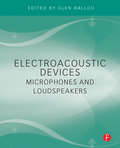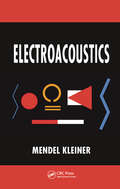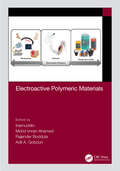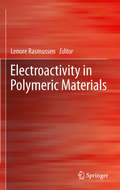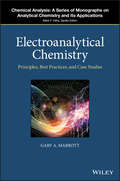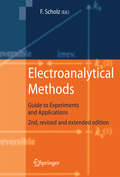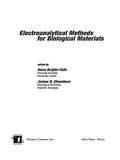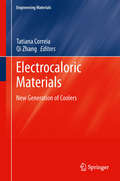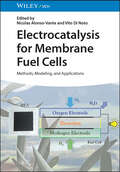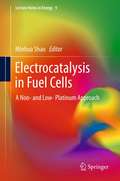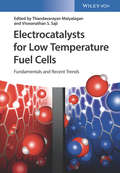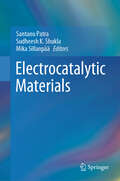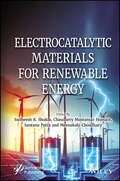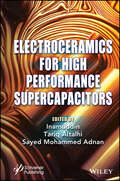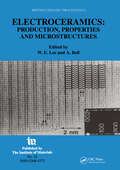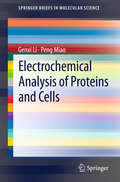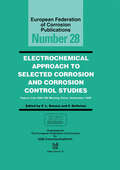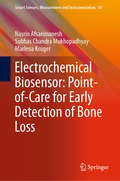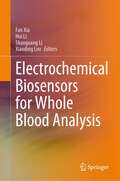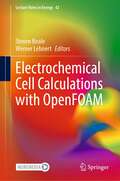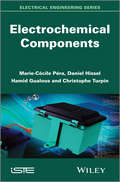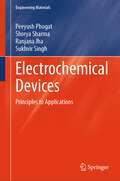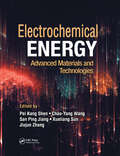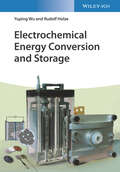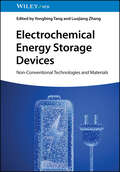- Table View
- List View
Electroacoustic Devices: Microphones And Loudspeakers
by Glen BallouThis is the definitive reference for microphones and loudspeakers, your one-stop reference covering in great detail all you could want and need to know about electroacoustics devises (microphones and loudspeakers). Covering both the technology and the practical set up and placement this guide explores and bridges the link between experience and the technology, giving you a better understanding of the tools to use and why, leading to greatly improved results.
Electroacoustics
by Mendel KleinerElectroacoustic devices such as microphones and loudspeakers are used everywhere from cars and mobile phones to homes, places of worship, and sports arenas. They are a key part of the modern communication society, helping to transmit information to our ears. A contemporary introduction to the subject, Electroacoustics explains the scientific and en
Electroactive Polymeric Materials
by InamuddinElectroactive polymers are smart materials that can undergo size or shape structural deformations in the presence of an electrical field. These lightweight polymeric materials possess properties such as flexibility, cost-effectiveness, rapid response time, easy controllability (especially physical to electrical), and low power consumption. Electroactive Polymeric Materials examines the history, progress, synthesis, and characterization of electroactive polymers and then details their application and potential in fields including biomedical science, environmental remediation, renewable energy, robotics, sensors and textiles. Highlighting the flexibility, lightweight, cost-effective, rapid response time, easy controllability, and low power consumption characteristics of electroactive polymers, respected authors in the field explore their use in sensors, actuators, MEMS, biomedical apparatus, energy storage, packaging, textiles, and corrosion protection to provide readers with a powerhouse of a reference to use for their own endeavors. Features: Explores the most recent advances in all categories of ionic/electroactive polymer composite materials Includes basic science, addresses novel topics, and covers multifunctional applications in one resource Suitable for newcomers, academicians, scientists and R&D industrial experts working in polymer technologies .
Electroactivity in Polymeric Materials
by Lenore RasmussenElectroactivity in Polymeric Materials provides an in-depth view of the theory of electroactivity and explores exactly how and why various electroactive phenomena occur. The book explains the theory behind electroactive bending (including ion-polymer-metal-composites -IPMCs), dielectric elastomers, electroactive contraction, and electroactive contraction-expansion cycles. The book also balances theory with applications - how electroactivity can be used - drawing inspiration from the manmade mechanical world and the natural world around us.
Electroanalytical Chemistry: Principles, Best Practices, and Case Studies (Chemical Analysis: A Series of Monographs on Analytical Chemistry and Its Applications)
by Gary A. MabbottProvides a strong foundation in electrochemical principles and best practices Written for undergraduate majors in chemistry and chemical engineering, this book teaches the basic principles of electroanalytical chemistry and illustrates best practices through the use of case studies of organic reactions and catalysis using voltammetric methods and of the measurement of clinical and environmental analytes by potentiometric techniques. It provides insight beyond the field of analysis as students address problems arising in many areas of science and technology. The book also emphasizes electrochemical phenomena and conceptual models to help readers understand the influence of experimental conditions and the interpretation of results for common potentiometric and voltammetric methods. Electroanalytical Chemistry: Principles, Best Practices, and Case Studies begins by introducing some basic concepts in electrical phenomena. It then moves on to a chapter that examines the potentiometry of oxidation-reduction processes, followed by another on the potentiometry of ion selective electrodes. Other sections look at: applications of ion selective electrodes; controlled potential methods; case studies in controlled potential methods; and instrumentation. The book also features several appendixes covering: Ionic Strength, Activity and Activity Coefficients; The Nicolsky-Eisenman Equation; The Henderson Equation for Liquid Junction Potentials; Selected Standard Electrode Potentials; and The Nernst Equation Derivation. Introduces the principles of modern electrochemical sensors and instrumental chemical analysis using potentiometric and voltammetric methods Develops conceptual models underlying electrochemical phenomena and useful equations Illustrates best practice with short case studies of organic reaction mechanisms using voltammetry and quantitative analysis with ion selective electrodes Offers instructors the opportunity to select focus areas and tailor the book to their course by providing a collection of shorter texts, each dedicated to a single field Intended as one of a series of modules for teaching undergraduate courses in instrumental chemical analysis Electroanalytical Chemistry: Principles, Best Practices, and Case Studies is an ideal textbook for undergraduate majors in chemistry and chemical engineering taking instrumental analysis courses. It would also benefit professional chemists who need an introduction to potentiometry or voltammetry.
Electroanalytical Methods
by Fritz ScholzResearchers and professionals will find a hands-on guide to successful experiments and applications of modern electroanalytical techniques here. The new edition has been completely revised and extended by a chapter on quartz-crystal microbalances. The book is written for chemists, biochemists, environmental and materials scientists, and physicists. A basic knowledge of chemistry and physics is sufficient for understanding the described methods. Electroanalytical techniques are particularly useful for qualitative and quantitative analysis of chemical, biochemical, and physical systems. Experienced experts provide the necessary theoretical background of electrochemistry and thoroughly describe frequently used measuring techniques. Special attention is given to experimental details and data evaluation.
Electroanalytical Methods Of Biological Materials
by Anna Brajter-TothThis text details contemporary electroanalytical strategies of biomolecules and electrical phenomena in biological systems. It presents significant developments in sequence-specific DNA detection for more efficient and cost-effective medical diagnosis of genetic and infectious diseases and microbial and viral pathogens. The authors discuss the latest advances in amperometric biosensing, capillary electrophoresis, DNA amplification and detection, single-cell neurochemistry, in vivo electrochemistry, and electrochemical immunoassay. They also present recent techniques to evaluate the reaction properties of complex electron-transport enzymes and describe the use of fast-scan cyclic voltammetry (FSCV) to study the mechanisms and kinetics of dopamine neurotransmission, among other topics.
Electrocaloric Materials
by Tatiana Correia Qi ZhangSince the 1997 Kyoto protocol of reduction of greenhouse gas emissions, the development of novel refrigerators has been a priority within the scientific community. Although magnetocaloric materials are promising candidates, they still need a large magnetic field to induce a giant ΔT as well as powerful and costly magnets. However, in electrocaloric materials (ECMs) a temperature change may be achieved by applying or removing an electric field. Since a giant electrocaloric effect on ferroelectric thin films was reported in Science in 2006, researchers have been inspired to explore such effect in different ferroelectric thin films. This book reviews electrocaloric effects observed in bulk materials as well as recent promising advances in thin films, with special emphasis on the ferroelectric, antiferroelectric and relaxor nature of ECMs. It reports a number of considerations about the future of ECMs as a means of achieving an efficient, ecologically sustainable and low cost refrigerator.
Electrocatalysis for Membrane Fuel Cells: Methods, Modeling, and Applications
by Nicolas Alonso-Vante Vito Di NotoElectrocatalysis for Membrane Fuel Cells Comprehensive resource covering hydrogen oxidation reaction, oxygen reduction reaction, classes of electrocatalytic materials, and characterization methods Electrocatalysis for Membrane Fuel Cells focuses on all aspects of electrocatalysis for energy applications, covering perspectives as well as the low-temperature fuel systems principles, with main emphasis on hydrogen oxidation reaction (HOR) and the oxygen reduction reaction (ORR). Following an introduction to basic principles of electrochemistry for electrocatalysis with attention to the methods to obtain the parameters crucial to characterize these systems, Electrocatalysis for Membrane Fuel Cells covers sample topics such as: Electrocatalytic materials and electrode configurations, including precious versus non-precious metal centers, stability and the role of supports for catalytic nano-objects; Fundamentals on characterization techniques of materials and the various classes of electrocatalytic materials; Theoretical explanations of materials and systems using both Density Functional Theory (DFT) and molecular modelling; Principles and methods in the analysis of fuel cells systems, fuel cells integration and subsystem design. Electrocatalysis for Membrane Fuel Cells quickly and efficiently introduces the field of electrochemistry, along with synthesis and testing in prototypes of materials, to researchers and professionals interested in renewable energy and electrocatalysis for chemical energy conversion.
Electrocatalysis in Fuel Cells
by Minhua ShaoFuel cells are one of the most promising clean energy conversion devices that can solve the environmental and energy problems in our society. However, the high platinum loading of fuel cells - and thus their high cost - prevents their commercialization. Non- or low- platinum electrocatalysts are needed to lower the fuel cell cost. Electrocatalysis in Fuel Cells: A Non and Low Platinum Approach is a comprehensive book summarizing recent advances of electrocatalysis in oxygen reduction and alcohol oxidation, with a particular focus on non- and low-Pt electrocatalysts. All twenty four chapters were written by worldwide experts in their fields. The fundamentals and applications of novel electrocatalysts are discussed thoroughly in the book. The book is geared toward researchers in the field, postgraduate students and lecturers, and scientists and engineers at fuel cell and automotive companies. It can even be a reference book for those who are interested in this area.
Electrocatalysts for Low Temperature Fuel Cells: Fundamentals and Recent Trends
by T. Maiyalagan Viswanathan S. SajiMeeting the need for a text on solutions to conditions which have so far been a drawback for this important and trend-setting technology, this monograph places special emphasis on novel, alternative catalysts of low temperature fuel cells. Comprehensive in its coverage, the text discusses not only the electrochemical, mechanistic, and material scientific background, but also provides extensive chapters on the design and fabrication of electrocatalysts. A valuable resource aimed at multidisciplinary audiences in the fields of academia and industry.
Electrocatalytic Materials
by Mika Sillanpää Sudheesh K. Shukla Santanu PatraThis handbook focuses on electrocatalytic materials, a field that has experienced significant advancements in recent decades, primarily driven by nanoscale catalyst design improvements. These advancements have been crucial in the development and enhancement of alternative energy technologies relying on electrochemical reactions. Electrocatalytic materials play a vital role in reducing over-potentials required for electrochemical device operation. As a prominent subset of catalysts, they facilitate essential reactions for energy conversion and storage through electron transfer processes. However, studying electrocatalytic materials presents challenges due to complex reaction networks, diverse selectivity possibilities, and intricate reaction mechanisms. This book offers an extensive description of electrocatalysis and the materials used in electrocatalytic processes. It covers cutting-edge studies and in-depth discussions on the applications of electrocatalytic materials in energy conversion and storage (including fuel cells, water splitting, batteries, etc.), sensors, and other potential applications. It also addresses the broader implications of electrocatalysis in academia and industry. Each section of the book highlights the latest developments, contemporary challenges, and state-of-the-art investigations aimed at producing valuable outcomes for end users. With contributions from diverse experts, this comprehensive resource is essential for researchers, scientists, industrialists, educators, and students.
Electrocatalytic Materials for Renewable Energy
by Sudheesh K. Shukla Chaudhery Mustansar Hussain Santanu Patra Meenakshi ChoudharyELECTROCATALYTIC MATERIALS FOR RENEWABLE ENERGY The book provides a comprehensive overview of various electrocatalytic materials and their applications in renewable energy thereby promoting a sustainable and clean energy future for all. As an important branch of catalysts, electrocatalytic materials exhibit important catalytic reactions that can convert and store energy through reactions involving electron transfer. However, the study of electrocatalytic materials presents a huge challenge due to the highly complicated reaction network, the variety of reaction selectivity, and the puzzling reaction mechanisms. Tremendous research efforts have been made toward the fabrication of efficient electrocatalytic materials that can be used in the energy sectors. The book covers a wide range of topics, including the synthesis, characterization, and performance evaluation of electrocatalytic materials for different renewable energy applications. Furthermore, the book discusses the challenges and opportunities associated with the development and utilization of electrocatalytic materials for renewable energy. The future utility of different electrocatalytic materials is also well-defined in the context of the renewable energy approach. The contributors to this book are leading experts in the field of electrocatalytic materials for renewable energy, including scientists and engineers from academia, industry, and national laboratories. Their collective expertise and knowledge provide valuable insights into the latest advances in electrocatalysis for renewable energy applications. Audience This book is intended for researchers and professionals in the fields of materials science, chemistry, physics, and engineering who are interested in the development and utilization of electrocatalytic materials for renewable energy.
Electroceramics for High Performance Supercapicitors
by Inamuddin Tariq Altalhi Sayed Mohammed AdnanELECTROCERAMICS FOR HIGH PERFORMANCE SUPERCAPACITORS The book describes the state-of-the-art analyses of high-density supercapacitors. In the near future, high-energy density materials will be required to accommodate the increased demand for gadgets, hybrid cars, and massive electrical energy storage systems. Fuel cells, supercapacitors, and batteries have the highest energy densities, but traditional capacitors have gained attention for intermittent energy harvesting owing to their high energy transfer rate and quick charging/discharging capability. The large amount of electric breakdown strength and modest remnant polarization are keys to the high energy density in dielectric capacitors. Above 100??C or 212??F, polymer dielectric capacitors become unstable and begin to suffer a dielectric breakdown. Hence, dielectric ceramics are the sole viable option for high-temperature applications. This book provides a basic understanding of dielectric-based energy harvesting. After a detailed analysis of the state-of-the-art, it proceeds to explain the specific strategies to enhance energy storage features, including managing the local structure and phases assembly, raising the dielectric width, and enhancing microstructure and electrical uniformity. Also discussed is the need for novel materials with applications in high-density supercapacitors. Audience The book is designed for engineers, industrialists, physicists, scientists, and researchers who work on the applications of high-density supercapacitors.
Electroceramics - Production, properties and microstructures: Proceedings of the Symposium Held as Part of the Condensed Matter and Materials Physics Conference, 20-22 December 1993, University of Leeds
by William E. Lee A. BellProceedings of the Symposium Held as Part of the Condensed Matter and Materials Physics Conference, on the 20-22 December 1993, at the University of Leeds. The man focus was Electroceramics - Production, properties and microstructures.
Electrochemical Analysis of Proteins and Cells
by Genxi Li Peng MiaoElectrochemical Analysis of Proteins and Cells presents the remarkable progress made over the years in the electrochemical analysis of proteins and cells, due to the rapid development of protein electrochemistry together with related technologies such as surface modification, molecular recognition, molecular assembly, and nanotechnology. As an interdisciplinary field combining electrochemistry, analytical chemistry, biochemistry, biophysics, biomedicine and material science, the electrochemical analysis of proteins and cells has attracted broad and extensive research interest. The main emphasis of this book is on the principles of electrochemical strategies and the practical utility of related detection systems, which is of great importance in all biological sciences, such as cell biology and molecular biology, as well as in biomedical fields like cancer research. This brief offers an up-to-date, easy-to-follow presentation of recent advances on the subject and can serve as a supplement for graduate-level courses in analytical chemistry, biochemistry, biophysics, biotechnology, biomedical engineering, etc. It may also help young scientists get an overview of this topic.
Electrochemical Approach to Selected Corrosion and Corrosion Control Studies (European Federation of Corrosion Publications)
by P. L. Bonora F. DeflorianThe collected papers from the 50th ISE Meeting held in Pavia , in September 1999. With special focus on Electrochemical Approach to Selected Corrosion And Corrosion Control Studies (number 28).
Electrochemical Biosensor: Point-of-Care for Early Detection of Bone Loss (Smart Sensors, Measurement and Instrumentation #30)
by Nasrin Afsarimanesh Subhas Chandra Mukhopadhyay Marlena KrugerThis book presents the design of a robust, portable and low-cost PoC sensing system for the early detection of bone loss. The device can measure the level of CTx-I – one of the most sensitive biochemical markers of bone resorption – in serum and transmit the measured value to an IoT-based cloud server. The selectivity of the sensing system to CTx-I has been achieved by coating the sensor with artificial antibodies, prepared by means of molecular imprinting technology. Explaining all aspects of the system’s development in detail, the book will be of great interest to all engineers, researchers and scientists whose work involves the development of electrochemical sensors and PoC devices.
Electrochemical Biosensors for Whole Blood Analysis
by Fan Xia Hui Li Shaoguang Li Xiaoding LouThis book illustrates recent advances in developing sensitive and selective electrochemical biosensors for their whole blood application. Known to be a cutting-edge and fast-growing technology, electrochemical biosensors demonstrate their potential in laboratories, industries, and healthcare to achieve specific and direct target detection in complex media, and have become an emerging technology for guiding personalized medicine. The book first demonstrates methods and models to cover the detection of a variety of target molecules in whole blood, including ions, small molecules, nucleic acids, proteins, cells, etc. Then, it provides comments on various detection strategies employed to improve sensors' sensitivity, specificity, selectivity, and reproducibility as well as presenting the laws and principles. In addition, it summarizes achievements and challenges from recent years. Finally, it provides future perspectives and opportunities in electrochemical biosensors including point of care detection, molecular diagnostics and the integration of this sensor platform with multidisciplinary technologies, towards the ultimate goal of personalized medicine. The book integrates abundant viewpoints from multiple sciences and is helpful and valuable to a wide readership in the various fields of biochemistry, biophysics, bioengineering, and pharmaceutics.
Electrochemical Cell Calculations with OpenFOAM (Lecture Notes in Energy #42)
by Steven Beale Werner LehnertThis unique book is at the nexus of modern software programming practices and electrochemical process engineering. It is the authoritative text on developing open source software for many applications, including:• fuel cells;• electrolyzers; and• batteries.Written by experts in the field in the open source computational fluid dynamics (CFD) code suite OpenFOAM, this book is intended for process engineering professionals developing practical electrochemical designs for industry, as well as researchers focused on finding tomorrow’s answers today. The book covers everything from micro-scale to cell-scale to stack-scale models, with numerous illustrations and programming examples. Starting from a clear explanation of electrochemical processes and simple illustrative examples, the book progresses in complexity through a range of diverse applications. After reading this book, the reader is able to take command and control of model development as an expert. The book is aimed at all engineers and scientists with basic knowledge of calculus and programming in C++.
Electrochemical Components
by Marie-Cécile PéraThis book focuses on the methods of storage commonly used in hybrid systems. After an introductory chapter reviewing the basics of electrochemistry, Chapter 2 is given over to the storage of electricity in the form of hydrogen. Once hydrogen has been made, we have to be able to convert it back into electricity on demand. This can be done with another energy converter: a fuel cell, the subject of Chapter 3. Such a system is unable to deliver significant dynamics in terms of storage and release of electricity and needs to be supplemented with another solution: a detailed study of supercapacitors is provided in Chapter 4.While the storage systems touched upon in the previous three chapters (hydrogen batteries and supercapacitors) both exhibit advantageous characteristics, at present they are still relatively costly. Thus, the days of the electrochemical accumulator by no means appear to be numbered just yet. This will therefore be the topic of Chapter 5. Finally, on the basis of the elements laid down in the previous chapters, Chapter 6 will focus on electrical hybridization of these storage systems, with a view to enhancing the performance (in terms of energy, lifetime, cost, etc.) of the newly formed system. Aimed at an audience of researchers, industrialists, academics, teachers and students, many exercises, along with corrected solutions, are provided throughout the book. Contents 1. Basic Concepts of Electrochemistry used in Electrical Engineering. 2. Water Electrolyzers. 3. Fuel Cells. 4. Electrical Energy Storage by Supercapacitors. 5. Electrochemical Accumulators. 6. Hybrid Electrical System. About the Authors Marie-Cécile Péra is a Full Professor at the University of Franche-Comte in France and Deputy Director of the FEMTO-ST Institute (CNRS). Her research activities include modeling, control and diagnosis of electric power generation systems (fuel cells – PEMFC and SOFC, supercapacities, batteries) for transportation and stationary applications. She has contributed to more than 180 articles in international journals and conferences. Daniel Hissel is Full Professor at the University of Franche-Comte in France and Director of the Fuel Cell Lab Research Federation (CNRS). He also leads a research team devoted to hybrid electrical systems in the FEMTO-ST Institute (CNRS). He has published more than 250 research papers on modeling, control, diagnostics and prognostics of hybrid electrical systems. Hamid Gualous is Full Professor at the University of Caen Lower Normandy in France and director of the LUSAC laboratory. His current research interests include power electronics, electric energy storage, power and energy systems and energy management. Christophe Turpin is Full Researcher at the CNRS (French National Center for Scientific Research). He is responsible for hydrogen activities within the Laboratory LAPLACE, Toulouse, France. His research activities include the characterization and modeling of fuel cells and electrolyzers, the state of health of these components, and their hybridization with other electrochemical components (ultracapacitors, batteries) within optimized energy systems for stationary and aeronautical applications.
Electrochemical Devices: Principles to Applications (Engineering Materials)
by Peeyush Phogat Shreya Sharma Ranjana Jha Sukhvir SinghThis book serves as a comprehensive guide for both beginners and researchers, offering insights into the diverse array of electrochemical devices and their intricate dependencies. It provides a comprehensive overview of electrochemical devices from fundamental principles to cutting-edge applications. By bringing together insights from materials science, chemistry, physics, engineering, and beyond, it offers a holistic understanding of the underlying mechanisms, design strategies, and practical considerations associated with these devices. The book begins by exploring of the fundamental principles of electrochemistry, laying the groundwork for understanding electrochemical reactions, charge transfer processes, and device operation mechanisms. Building upon this foundation, it delves into various types of electrochemical devices, including solar cells, photodetectors, sensors, batteries, and more.
Electrochemical Energy: Advanced Materials and Technologies (Electrochemical Energy Storage and Conversion)
by Chao-Yang Wang Jiujun Zhang Xueliang Sun San Ping Jiang Pei Kang ShenElectrochemical Energy: Advanced Materials and Technologies covers the development of advanced materials and technologies for electrochemical energy conversion and storage. The book was created by participants of the International Conference on Electrochemical Materials and Technologies for Clean Sustainable Energy (ICES-2013) held in Guangzhou, China, and incorporates select papers presented at the conference. More than 300 attendees from across the globe participated in ICES-2013 and gave presentations in six major themes: Fuel cells and hydrogen energy Lithium batteries and advanced secondary batteries Green energy for a clean environment Photo-Electrocatalysis Supercapacitors Electrochemical clean energy applications and markets Comprised of eight sections, this book includes 25 chapters featuring highlights from the conference and covering every facet of synthesis, characterization, and performance evaluation of the advanced materials for electrochemical energy. It thoroughly describes electrochemical energy conversion and storage technologies such as batteries, fuel cells, supercapacitors, hydrogen generation, and their associated materials. The book contains a number of topics that include electrochemical processes, materials, components, assembly and manufacturing, and degradation mechanisms. It also addresses challenges related to cost and performance, provides varying perspectives, and emphasizes existing and emerging solutions. The result of a conference encouraging enhanced research collaboration among members of the electrochemical energy community, Electrochemical Energy: Advanced Materials and Technologies is dedicated to the development of advanced materials and technologies for electrochemical energy conversion and storage and details the technologies, current achievements, and future directions in the field.
Electrochemical Energy Conversion and Storage
by Yuping Wu Rudolf HolzeThis pioneering textbook on the topic provides a clear and well-structured description of the fundamental chemistry involved in these systems, as well as an excellent overview of the real-life practical applications. Prof. Holze is a well-known researcher and an experienced author who guides the reader with his didactic style, and readers can test their understanding with questions and answers throughout the text. Written mainly for advanced students in chemistry, physics, materials science, electrical engineering and mechanical engineering, this text is equally a valuable resource for scientists and engineers working in the field, both in academia and industry.
Electrochemical Energy Storage Devices: Non-Conventional Technologies and Materials
by Yongbing Tang Luojiang ZhangSystematic and insightful overview of various novel energy storage devices beyond alkali metal ion batteries for academic and industry Electrochemical Energy Storage Devices delivers a comprehensive review of promising energy storage devices with the potential for higher energy and power density, longer lifetime cycle, better safety performance, and lower costs and environmental footprint compared to traditional lithium-ion batteries. The book covers the fundamentals of energy storage devices and key materials (cathode, anode, and electrolyte) and discusses advanced characterization techniques to allow for further improvement of their electrochemical performance. Current challenges and future outlooks in the field are also discussed. Written by a highly qualified academic with significant research experience in the field, Electrochemical Energy Storage Devices includes information on sample topics including: Mechanisms and promising cathode catalysts for metal air batteries and mechanisms and advanced materials for metal-CO2 batteries Magnesium-based and other types of multivalent-ion batteries and M/N/C catalysts for fuel cells Developments and prospects of aqueous batteries and progress and perspectives of material design and engineering in flow batteries Rechargeable lithium-sulfur batteries, dual-ion batteries, hybrid capacitors, and flexible energy storage devices Explaining working mechanisms and laying the groundwork for innovative optimization strategies, Electrochemical Energy Storage Devices is an essential reference on the subject for materials scientists and chemists.
